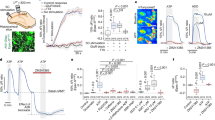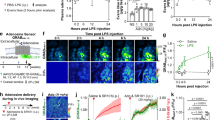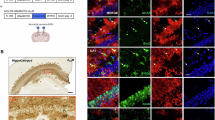Abstract
The inhibitory neuromodulator adenosine is released in the brain in high concentrations under conditions of exaggerated neuronal activity such as ischemia and seizures, or electroconvulsive treatment. By inhibiting neural overactivity, adenosine counteracts seizure activity and promotes neuronal survival. Since stimulation of adenosine A2b receptors on astrocytes induces increased synthesis and release of interleukin-6, which also exerts neuroprotective effects, we hypothesized that the effects of interleukin-6 and of adenosine might be related. We report here that stimulation with interleukin-6 of cultured astrocytes, of cultured organotypic brain slices from newborn rat cortex, and of freshly prepared brain slices from rat cortex induces a concentration- and time-dependent upregulation of adenosine A1 receptor mRNA. This increased adenosine A1 receptor mRNA expression is accompanied in astrocytes by an increase in adenosine A1 receptor-mediated signaling via the phosphoinositide-dependent pathway. Since upregulation of adenosine A1 receptors leads to increased neuroprotective effects of adenosine, we suggest that the neuroprotective actions of interleukin-6 and adenosine are related and might be mediated at least in part through upregulation of adenosine A1 receptors. These results may be of relevance for a better understanding of neuroprotection in brain damage but also point to a potential impact of neuroprotection in the mechanisms of the antidepressive effects of chronic carbamazepine, electroconvulsive therapy, and sleep deprivation, which are all accompanied by adenosine A1 receptor upregulation.
Similar content being viewed by others
Log in or create a free account to read this content
Gain free access to this article, as well as selected content from this journal and more on nature.com
or
References
Abbracchio MP, Cattabeni F . (1999): Brain adenosine receptors as targets for therapeutic intervention in neurodegenerative diseases. Ann N Y Acad Sci 890: 79–92
Angelatou F, Pagonopoulou O, Maraziotis T, Olivier A, Villemeure JG, Avoli M, Kostopoulos G . (1993): Upregulation of A1 adenosine receptors in human temporal lobe epilepsy: A quantitative autoradiographic study. Neurosci Lett 163 (1)): 11–14
Altar CA . (1999): Neurotrophins and depression. Trends Pharmacol Sci 20: 59–61
Ayane M, Nielsen P, Köhler G . (1989): Cloning and sequencing of mouse ribosomal protein S12 cDNA. Nucleic Acid Res 17: 6722–6728
Biber K, Walden J, Gebicke-Haerter PJ, Berger M, van Calker D . (1996): Carbamazepine inhibits the potentiation by adenosine analogues of agonist induced inositolphophosphate formation in hippocampal astrocyte cultures. Biol Psychiatry 40: 563–567
Biber K, Klotz K-N, Berger M, Gebicke-Haerter PJ, van Calker D . (1997): Adenosine A1 receptor-mediated activation of phospholipase C in cultured astrocytes depends on the level of receptor expression. J Neurosci 17: 4956–4964
Biber K, Fiebich B, Gebicke-Härter PJ, van Calker D . (1999): Carbamazepine-induced upregulation of adenosine A1-receptors in astrocyte cultures affects coupling to the phosphoinositol signaling pathway. Neuropsychopharmacology 20: 271–278
Campbell IL . (1998): Transgenic mice and cytokine actions in the brain: Bridging the gap between structural and functional neuropathology. Brain Res Rev 26: 327–336
Chomczynski P, Sacchi N . (1987): Single step method of RNA isolation by acid guanidinium thiocyanate-phenol-chloroform extraction. Anal Biochem 162: 156–159
Ciccarelli R, Di Iorio P, Bruno V, Battaglia G, D'Alimonte I, D'Onofrio M, Nicoletti F, Caciagli F . (1999): Activation of A1 adenosine or mGLU3 metabotropic glutamate receptors enhances the release of nerve growth factor and S-100β protein from cultured astrocytes. GLIA 27: 275–281
Clark M, Post RM . (1989): Carbamazepine, but not caffeine, is highly selective for adenosine A1 binding sites. Eur J Pharmacol 164: 399–401
Daval J-L, Deckert J, Weiss SRB, Post RM, Marangos PJ . (1989): Upregulation of adenosine A1-receptors and forskolin binding sites following chronic treatment with caffeine or carbamazepine. Epilepsia 30: 26
Deckert J, Gleiter CH . (1994): Adenosine—an endogenous neuroprotective metabolite and neuromodulator. J Neural Trans Suppl 43: 23–31
Diviacco S, Norio P, Zentilin L, Menzo S, Clementim M, Biamonti G, Riva S, Falaschi A, Giacca M . (1992): A novel procedure for quantitative polymerase chain reaction by coamplification of competitive templates. Gene 122: 313–320
Dragunow M . (1988): Purinergic mechanisms in epilepsy. Prog Neurobiol 31: 85–108
Duman RS, Heninger GR, Nestler EJ . (1997): A molecular and cellular theory of depression. Arch Gen Psychiatry 54: 597–606
Dux E, Fastbom J, Ungerstedt U, Rudolphi KA, Fredholm BB . (1990): Protective effect of adenosine and a novel xanthine derivative propentofylline on the cell damage after bilateral carotid occlusion in the gerbil hippocampus. Brain Res 516: 248–256
Fiebich BL, Biber K, Gyufko K, Berger M, Bauer J, van Calker D . (1996): Adenosine A2b receptors mediate an increase in interleukin (IL)-6 mRNA and IL-6 protein synthesis in human astroglioma cells. J Neurochem 66: 1426–1431
Fredholm BB, Abbrachio MP, Burnstock G, Daly JW, Harden KT, Jacobson KA, Leff P, Williams M . (1994): VI. Nomenclature and classification of purinoceptors. Pharmacol Rev 46: 143–156
Frotscher M, Heimrich B . (1993): Formation of layer-specific fiber projection to the hippocampus in vitro. Proc Natl Acad Sci U S A 90: 10400–10403
Gadient RA, Otten U . (1996): Postnatal expression of interleukin-6 (IL-6) and IL-6 receptor (IL-6R) mRNAs in rat sympathetic and sensory ganglia. Brain Res 724: 41–46
Gadient RA, Otten UH . (1997): Interleukin-6 (IL-6): A molecule with both beneficial and destructive potentials. Prog Neurobiol 52: 379–390
Gähwiler BH, Capogna M, Debanne D, McKinney RA, Thompson SM . (1997): Organotypic slice cultures: A technique has come of age. Trends Neurosci 20: 471–477
Galea JH, Feinstein DL . (1992): Rapid synthesis of DNA deletion constructs for mRNA quantification: Analysis of astrocyte mRNA. PCR Methods Appl 2: 66–69
Gleiter CH, Deckert J, Nutt DJ . (1989): Electroconvulsive shock (ECS) and the adenosine neuromodulatory system: Effect of single and repeated ECS on the adenosine A1 and A2 receptors, adenylate cyclase, and the adenosine uptake site. J Neurochem 52: 641–646
Groul DL, Nelson TE . (1997): Physiological and pathological roles of interleukin-6 in the central nervous system. Mol Neurobiol 15: 307–339
Hagberg H, Gilland E, Bona E, Hanson LA, Hahin-Zoric M, Blennow M, Holst M, McRae A, Soder O . (1996): Enhanced expression of interleukin (IL)-1 and IL-6 messenger RNA and bioactive protein after hypoxia-ischemia in neonatal rats. Pediatr Res 40: 603–609
Hettinger BD, Leid M, Murray TF . (1998): Cyclopentyladenosine-induced homologous down-regulation of A1 adenosine receptors (A1AR) in intact neurones is accompanied by receptor sequestration but not a reduction in A1AR mRNA expression or G protein alpha-subunit content. J Neurochem 71: 221–230
Heurteaux C, Lauritzen I, Widman C, Lazdunski M . (1995): Essential role of adenosine, adenosine A1 receptors, and ATP-sensitive K+ channels in cerebral ischemic preconditioning. Proc Natl Acad Sci U S A 92: 4666–4670
Huston JP, Haas HL, Boix F, Pfister M, Decking U, Schrader J, Schwarting RKW . (1996): Extracellular adenosine levels in neostriatum and hippocampus during rest and activity periods of rats. Neuroscience 73: 99–107
Kushima Y, Hama T, Hatanaka H . (1992a): Interleukin-6 as a neurotrophic factor for promoting the survival of cultured catecholaminergic neurones in a chemically defined medium from fetal and postnatal rat midbrains. Neurosci Res 13: 267–280
Kushima Y, Hatanaka H . (1992b): Interleukin-6 and leukemia inhibitory factor promote the survival of acetylcholinesterase-positive neurones in culture from embryonic rat spinal cord. Neurosci Lett 143: 110–114
Loddick SA, Turnbull AV, Rothwell NJ . (1998): Cerebral interleukin-6 is neuroprotective during permanent focal cerebral ischemia in the rat. J Cereb Blood Flow Metab 18: 176–179
Maeda Y, Matsumoto M, Hori O, Kuwabara K, Ogawa S, Yan SD, Ohtsuki T, Kinoshita T, Kamada T, Stern DM . (1994): Hypoxia/reoxygenation-mediated induction of astrocyte interleukin 6: A paracrine mechanism potentially enhancing neurone survival. J Exp Med 180: 2297–2308
Maerz P, Cheng J-R, Gadient RA, Patterson PH, Stoyan T, Otten U, Rose-John S . (1998): Sympathetic neurones can produce and respond to interleukin-6. Proc Natl Acad Sci U S A 95: 3251–3256
Mahan LC, McVittie LD, Smyk-Randall EM, Nakata H, Monsma FJ, Gerfen CR, Sibley DR . (1991): Cloning and expression of an A1 adenosine receptor from rat brain. Mol Pharmacol 40: 1–7
Manji HK, Moore GJ, Chen G . (2000): Lithium up-regulates the cytoprotective protein Bcl-2 in the CNS in vivo: A role for neurotrophic and neuroprotective effects in manic depressive illness. J Clin Psychiatry 61(Suppl 9): 82–96
Matsuda S, Wen TC, Morita F, Otsuka H, Igase K, Yoshimura H, Sakanaka M . (1996): Interleukin-6 prevents ischemia-induced learning disability and neuronal and synaptic loss in gerbils. Neurosci Lett 204: 109–112
Merrill JE, Jonakait GM . (1995): Interactions of the nervous and immune system in development, normal brain homeostasis, and disease. FASEB J 9: 611–618
Munoz-Fernandez MA, Fresno M . (1998): The role of tumour necrosis factor, interleukin 6, interferon-gamma and inducible nitric oxide synthase in the development and pathology of the nervous system. Prog Neurobiol 56: 307–340
Murphy GM Jr, Yang L, Cordell B . (1998): Macrophage colony-stimulating factor augments beta-amyloid-induced interleukin-1, interleukin-6, and nitric oxide production by microglial cells. J Biol Chem 273: 20967–20971
Newby AC . (1984): Adenosine and the concept of “retaliatory metabolites”. Trends Biochem Sci 3: 42–44
Newman M, Zohar J, Kalian M, Belmaker RH . (1984): The effects of chronic lithium and ECT on A1 and A2 adenosine systems in the brain. Brain Res 291: 188–192
Olah ME, Stiles GL . (1995): Adenosine receptor subtypes: Characterization and therapeutic regulation. Annu Rev Pharmacol Toxicol 35: 581–606
Pagonopoulou O, Angelatou F, Kostopoulos G . (1993): Effect of pentylentetrazol-induced seizures on A1 adenosine receptor regional density in the mouse brain: A quantitative autoradiographic study. Neuroscience 6: 711–716
Penkowa M, Moos T, Carrasco J, Hadberg H, Molinero A, Bluethmann H, Hidalgo J . (1999): Strongly compromised inflammatory response to brain injury in interleukin-6-deficient mice. GLIA 25: 343–357
Picano E, Abbracchio MP . (1998): European stroke prevention study-2 results: Serendipitous demonstration of neuroprotection induced by adenosine accumulation? Trends Pharmacol Sci 19: 14–16
Porkka-Heiskanen T . (1999): Adenosine in sleep and wakefulness. Ann Med 31 (2)): 125–129
Porkka-Heiskanen T, Strecker RE, Thakkar M, Bjorkum AA, Greene RW, McCarley RW . (1997): Adenosine: A mediator of the sleep-inducing effects of prolonged wakefulness. Science 276: 1265–1268
Ralevic V, Burnstock G . (1998): Receptors for purines and pyrimidines. Physiol Rev 50: 413–492
Ribeiro JA . (1995): Purinergic inhibition of neurotransmitter release in the central nervous system. Pharmacol Toxicol 77: 299–305
Rudolphi KA, Schubert P . (1996): Purinergic interventions in traumatic and ischemic injury. In Peterson PL, Phillis JW (eds), Novel Therapies for CNS Injuries. CRC Press, Inc., Boca Raton, New York, London, Tokyo pp 327–342
Rudolphi KA, Schubert P, Parkinson FE, Fredholm B . (1992a): Neuroprotective role of adenosine in cerebral ischemia. Trends Pharmacol Sci 13: 439–445
Rudolphi KA, Schubert P, Parkinson FE, Fredholm BB . (1992b): Adenosine and brain ischemia. Cerebrovasc Brain Metab Rev 4: 346–369
Ruiz A, Sanz JM, Gonzalez-Calero G, Fernandez M, Andres A, Cubero A, Ros M . (1996): Desensitization and internalization of adenosine A1 receptors in rat brain by in vivo treatment with R-PIA: Involvement of coated vesicles. Biochim Biophys Acta 1310: 168–174
Schiefer J, Topper R, Schmidt W, Block F, Heinrich PC, Noth J, Schwarz M . (1998): Expression of interleukin 6 in the rat striatum following stereotaxic injection of quinolinic acid. J Neuroimmunol 89: 168–176
Schobitz B, de Kloet ER, Sutanto W, Holsboer F . (1993): Cellular localization of interleukin 6 mRNA and interleukin 6 receptor mRNA in rat brain. Eur J Neurosci 11: 1426–1435
Schubert P, Ogata T, Marchini C, Ferroni S, Rudolphi KA . (1997): Protective mechanism of adenosine in neurones and glial cells. Ann N Y Acad Sci 825: 1–10
Schwaninger M, Neher M, Viegas E, Schneider A, Spranger M . (1997): Stimulation of interleukin-6 secretion and gene transcription in primary astrocytes by adenosine. J Neurochem 69: 1145–1150
Sutherland GR, Peeling J, Lesiuk HJ, Brownstone RM, Rydzy M, Saunders JK, Geiger JD . (1991): The effects of caffeine on ischemic neuronal injury as determined by magnetic resonance imaging and histopathology. Neuroscience 42: 171–182
Toulmond S, Vige X, Fage D, Benavides J . (1992): Local infusion of interleukin-6 attenuates the neurotoxic effects of NMDA on rat striatal cholinergic neurones. Neurosci Lett 144: 49–52
van Calker D, Müller M, Hamprecht B . (1978): Adenosine inhibits the accumulation of cyclic AMP in cultured brain cells. Nature 276: 839–841
van Calker D, Müller M, Hamprecht B . (1979): Adenosine regulates via two different types of receptors the accumulation of cyclic AMP in cultured brain cells. J Neurochem 33: 999–1005
van Calker D, Steber R, Klotz K-N, Greil W . (1991): Carbamazepine distinguishes between adenosine receptor subtypes that mediate, respectively, regulation of cyclic AMP formation and inhibition of inositolphosphate formation. Eur J Pharmacol 206: 285–290
van Calker D, Biber K, Walden J, Gebicke P, Berger M . (2000): Carbamazepine and adenosine receptors. In Manji HK, Bowden CL, Belmaker RH (eds), Bipolar Medications, Mechanism of Action. Washington, DC, American Psychiatric Press, pp 331–346
Williams M . (1995): Purinoceptors in central nervous system function. In Bloom FE, Kupfer DJ (eds), Psychopharmacology: The Fourth Generation of Progress. New York, Raven Press, pp 643–655
Yamada M, Hatanaka H . (1994): Interleukin-6 protects cultured rat hippocampal neurones against glutamate-induced cell death. Brain Res 643: 173–180
Yanik GM, Radulovacki M . (1987): REM sleep deprivation upregulates adenosine A1 receptors. Brain Res 402: 362–364
Acknowledgements
The authors wish to thank Dr. K.-N. Klotz for helpful discussions and support. This work was supported by the Deutsche Forschungsgemeinschaft grant No. Ca 115/5–2.
Author information
Authors and Affiliations
Rights and permissions
About this article
Cite this article
Biber, K., Lubrich, B., Fiebich, B. et al. Interleukin-6 Enhances Expression of Adenosine A1 Receptor mRNA and Signaling in Cultured Rat Cortical Astrocytes and Brain Slices. Neuropsychopharmacol 24, 86–96 (2001). https://doi.org/10.1016/S0893-133X(00)00169-X
Received:
Revised:
Accepted:
Issue date:
DOI: https://doi.org/10.1016/S0893-133X(00)00169-X
Keywords
This article is cited by
-
Neurobiological Correlates of Alpha-Tocopherol Antiepileptogenic Effects and MicroRNA Expression Modulation in a Rat Model of Kainate-Induced Seizures
Molecular Neurobiology (2018)
-
Serum and CSF adiponectin, leptin, and interleukin 6 levels as adipocytokines in Egyptian children with febrile seizures: a cross-sectional study
Italian Journal of Pediatrics (2016)
-
Interleukin-6 gene polymorphisms in Egyptian children with febrile seizures: a case–control study
Italian Journal of Pediatrics (2016)
-
Microglia trigger astrocyte-mediated neuroprotection via purinergic gliotransmission
Scientific Reports (2014)
-
Purinoceptors on Neuroglia
Molecular Neurobiology (2009)



